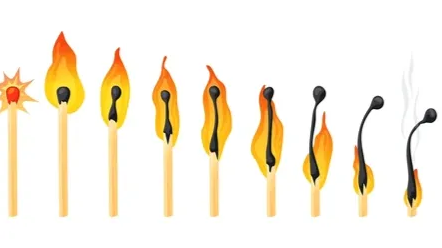
The key to keeping your spark alive: beat burnout
‘It’s better to burn out than to fade away’. So sang Neil Young on his 1979 track, Hey, Hey, My, My. What does that line mean to you? I think it’s saying that it’s better to go out in a blaze of glory than to fizzle out and slip into obscurity. It’s what I imagine people think of when they’re going hard instead of going home, just before they hit burnout.
Burnout is a state of exhaustion. It can have severe impact on your physical, emotional, or mental wellbeing (or all three at once). While the World Health Organization doesn’t recognise burnout as a medical or mental health condition, it does classify it as a syndrome (a collection of symptoms or signs associated with a specific health-related cause). They’ve recently called it ‘an occupational phenomenon’. And we can’t caffeinate our way out of this one.
Why do I think the lyrics are apt for this conversation? Because in the workplace, I believe we sometimes feel there’s a correlation between overworking and getting ahead, or even getting noticed. That if we don’t work to excess, our input and value won’t be recognised, and we’ll be overlooked for promotions or pay rises. I’m not saying it’s all self-led. Our job title and workload can dictate the hours and energy we feel the need, or pressure, to put in. But I think that sometimes, some of us fuel it with the pressure we put on ourselves. The overachievers. The providers. The worth provers. We need to be ‘always on’, ‘always available’, ‘always relevant’.
I’ve been that person. Wanting to prove leaving home and education so young wouldn’t hinder my professional success. Needing to earn enough to keep a roof over my head – with the lights (and broadband) on. Taking on a leadership role where support for leaders was seriously lacking. Burning the midnight oil because ‘the buck stopped’ with me. (Note: I’ve since come to recognise that ‘the buck’ doesn’t always stop at a leader, but sometimes at the person who has to deliver the work.)
From fired up to burnt out
The cost? My relationships. My physical health. Mental stability. Emotional wellbeing. Everything slowly depleted. I went from having a fire in my belly for my job and my relationships, both in and out of work, to utterly fatigued. Because, you see, burnout takes your ability to function to the brink. Unlike stress, where you’re often still able to engage with the activity causing it, burnout causes you to become detached and dispirited. Motivation – extinguished. Outlook – bleak.
Symptoms look different for everyone. Physically you might be feeling tired most of the time, suffer from sleep disturbances, muscle or joint pain, frequent illness due to low immunity. Emotional symptoms can include feeling overwhelmed, helpless or worthless. Like a failure. A lacking sense of satisfaction and achievement. And behaviourally, someone might procrastinate, have difficulty concentrating. They might be irritable, frequently late or absent. And they may become reliant on food, drugs or alcohol to cope.
Mental Health UK recently released The Burnout Report which found that 9 in 10 adults have experienced high or extreme stress in the past year. And 1 in 5 have needed to take time off work due to poor mental health caused by pressure or stress. The stats are clear. And even well-known figures have spoken about their own experiences. Sandra Bullock, Jürgen Klopp, Prince Harry. New Zealand’s Prime Minister, Jacinda Arden stepped down from her role last year because she, “no longer had enough in the tank” to do the job.
Prevention is better than cure
But coming to a complete standstill isn’t possible for us all. Not everyone has the luxury to resign or take a sabbatical. And burnout’s not just a problem in the professional sphere – our world outside of work can play a part too. Which is why finding balance is even more crucial. Our workplaces do have a role to play in keeping us fired up. The Burnout Report found that nearly half of workers (49%) said their employer doesn’t have a plan to spot the signs of chronic stress and prevent burnout in the workplace, and just 29% of people knew what plans their employers had in place.
Strategies and policies should be implemented to prevent and support colleagues struggling with stress or burnout. Access to resources such as Mental Health First Aiders and counselling services should be standard. As should regular check-ins with employees to discuss expectations and work challenges. Acknowledging and celebrating colleagues’ contributions and successes. And fostering an open, supportive culture where raising concerns over unmanageable workloads and deadlines is welcomed.
It’s important we all take control of our own wellbeing too. Writing to-do lists, taking proper breaks and incorporating boundaries can help. But managing your time, learning how to delegate and reevaluating your priorities, goals and ambitions will also go a long way. How many meetings can you realistically schedule, while still leaving enough time to get through that to-do list within the workday? How many competing deadlines are you facing right now? Are you being mindful about your ‘yeses’?
Work aside, what are you doing in your personal life that’s really personal to you? Hobbies, self-care, R&R – what’s filling up your cup? I’ve had countless conversations with people telling them to ‘slow down’, ‘take a break’, ‘sick leave’s not just for physical health’, i.e. you can’t pour from an empty cup. But on reflection, the point isn’t to refill (or refuel) just so you can go right back to pouring into your project/to-do list/career. It’s so you can be of sound mind and body to keep pouring into yourself.
And let’s not forget, as Neil also crooned, ‘there’s more to the picture than meets the eye’. So be sure to check in with each other.
Post a comment